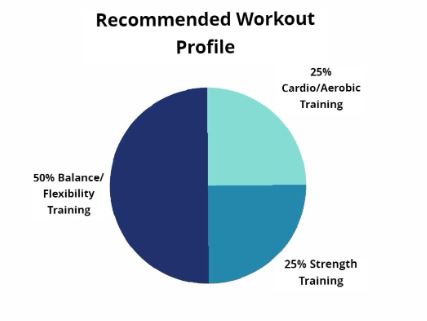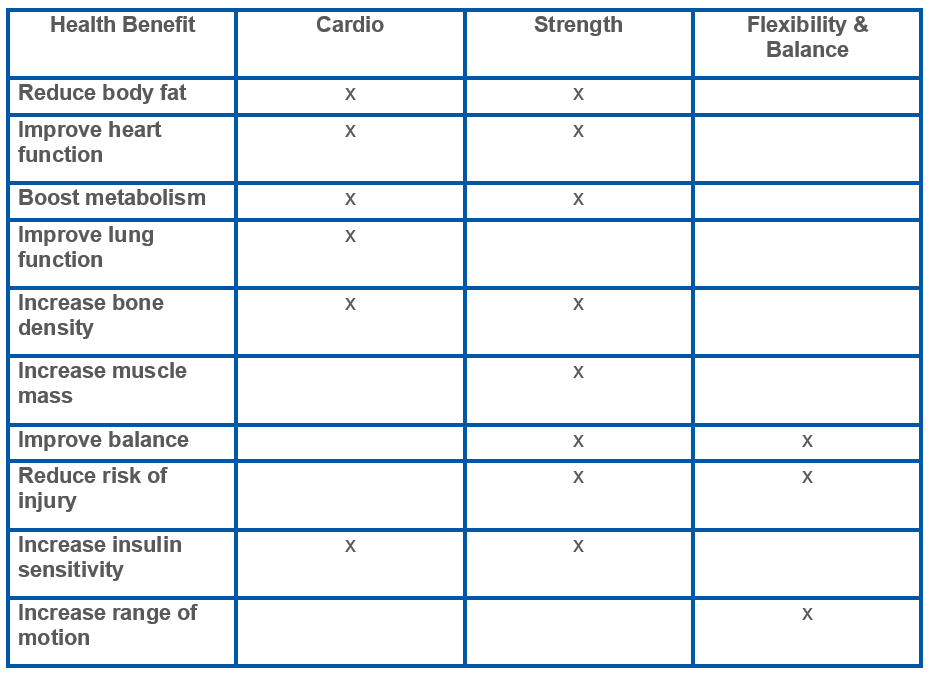Are You Getting the Most Out of Your Workout?
- Category: Community Health, Health Tips
- Posted On:
What’s your favorite food? Pizza? Fish tacos? General Tso’s chicken? Always delicious but what if you had to eat it every day? Not so wonderful. Yet that’s the approach many of us take to exercising. Autopilot. We go through the same motions time after time, thinking about anything but our workout.
Tips for Improving Your Workouts Effectiveness:
Mixing it up can make all the difference in your exercise program. Varying your workout helps:
- Alleviate boredom
- Keep you engaged in your fitness routine
- Minimize the risk of injury
- Reduce plateaus
- Decrease your risk of heart disease, arthritis, disability, and some types of cancer

The pie chart (right) illustrates our recommended workout profile: 25% cardio, 25% strength, and 50% balance and flexibility. You may be surprised at the emphasis on balance and flexibility, but the older you get, the more you will experience the need for this type of training.
Cardio for Healthy Heart and Lungs
Cardio, or Aerobic exercise, is any activity that engages the large muscles of the body — thighs, butt, back, and chest — for at least ten minutes. Walking fast, running, swimming, and cycling are all cardiovascular exercise that challenge your heart and lungs.
The American Heart Association recommends at least 150 minutes per week of moderate-intensity aerobic activity or 75 minutes per week of vigorous aerobic activity. If you enjoy physical activity or are trying to lose weight, shoot for more than this minimum standard. Intensity makes a difference. We recommend working out at 55 to 90 percent of your maximum heart rate, depending on your age and health. Rather than exhaust yourself by shooting for maximum intensity for long periods of time, add intervals to your work out. If you’re walking, break into a two- or three- minute jog. Use the interval setting on exercise equipment.
Are your workouts age-appropriate? Set up a consultation to talk to our trainer about it. As you age, you become more vulnerable to injury. Rather than go full-bore, decrease the intensity but workout longer and/or more frequently. You will continue to reap the benefits of regular cardiovascular exercise.
Strength for Healthy Muscles and Bones
Strength, or resistance training builds muscular strength and endurance by moving against resistance from free weights, resistance bands, weight machines, body bars, stability balls, or even water, as in water aerobics. Resistance training helps improve bone health, support joints, boost your aerobic workouts, and slow the bone loss that happens naturally over time. Working with our personal trainer can help you develop a routine that’s right for your age and fitness level.
Aim for at least three 10-minute sessions of strength training a week. You don’t have to lift very heavy weights — lighter weight loads are just as effective, and you can always increase the number of reps. Be sure to allow at least 48 hours between strength-training sessions. As you age, you may want to spend more time strength training to keep your bones and muscles as strong as possible.
Flexibility and Balance to Keep You Moving
Flexibility training is a low intensity form of exercise designed to improve or maintain your range of motion. Remaining flexible decreases your risk for muscle imbalances — when you compensate for weakness in one muscle by overworking another. Such imbalances make you more susceptible to injuries and falls. Flexibility also makes it easier to move through everyday life, reaching for objects on a high shelf, bending down to pick something up off the floor, or getting up out of a low, cushy chair.
There are plenty of fun options to help you stay flexible, such as Pilates, yoga, tai chi, and chi-gong. Never push yourself when working your flexibility: If it hurts, stop. Stretching too far beyond your range of motion can cause injuries. Aim for two to three weekly sessions of balance and flexibility exercises, for a total of at least 60 minutes.
A Well-Rounded Fitness Regimen
A combination of aerobic, strength, and flexibility training will help you stay healthy and strong. The chart below details the benefits of each type of exercise.

